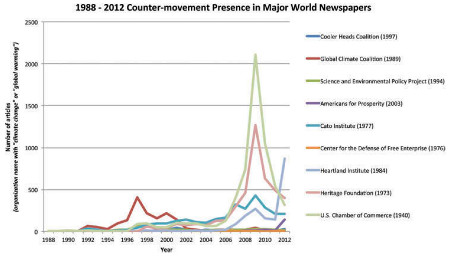Climate contrarians are more celebrity than scientist
By now, we must all be aware that it no longer takes hard work and talent to become a celebrity. The media (and public) are drawn to loud and flamboyant caricatures, not careful and studious characters. To most this means not much more than the annoyance of hearing about the latest celebrity "scandal." But for all of us here on planet Earth, it has very real consequences.
New research clarifies exactly what those consequences are: Celebrities in scientists' lab coats have played a role in the public discourse on climate change that far outweighs their scientific credibility.
In the journal Celebrity Studies, Dr. Maxwell Boykoff and Shawn Olson trace the history of climate contrarians back to the 1980s and discuss their potential motivations and strategies. The study identifies these contrarians as a "keystone species;" climate contrarians are more influential than their scant numbers and limited expertise would suggest, and exert an outsized media impact. According to the authors, it's these keystone species that hold the ecosystem of climate denial together. Since, as we all know, 97% of climate scientists affirm the reality of human-caused climate change, what is it that motivates this handful of contrarians who make no small effort to attract so much more than 3% of the media's attention?
The 1960s and 1970s brought a wave of environmentalism through America. By the 1980s, conservatives were ready for their own counter-movement. Out of the earlier "Sagebrush Rebellion" and a desire to stem conservation efforts in the American west, the "Wise Use" movement gained prominence in 1988. The authors explain how members of trade organizations and off-roaders came together at a Christian-right conference to create "a unified platform aimed to 'destroy environmentalism.' "
This movement, the authors argue, marked the creation of the specious dichotomy of environment versus economy as well as an early example of astroturfing — when you present an organization funded and defined by corporate interests as supposedly grassroots. The "grassroots" Wise-Use movement counted none other than President of the United States Ronald Reagan among its supporters.
The Wise Use movement claimed to fight distant urban elite environmentalists on behalf of everyday rural residents. In reality, the movement itself was closely tied to and funded by urban elites and their corporations, and the movement served the business interests of these institutions. Coalescing under the auspices of free-market ideology, Wise Use argued that environmental regulations threatened the profits of companies, and insisted the residents of the environment being regulated had a right to speak out.
For those who have read about climate denial, the Wise Use language will be immediately recognizable. Accusations of "bad science," unsupported claims that environmental regulations have "been costly to people and harmful to the land," and the wholesale dismissal of the growing fields of ecology and environmental science were the staples of their rhetoric.
How has this toxic terminology fared over the years? To answer, the paper provides an interesting graph that tracks the media's coverage of various contrarian groups.
 Climate countermovement presence in English-language news outlets, 1988–2012. This graphic represents nine of the 110 groups that were identified as the ‘core’ of the US climate countermovement. Years noted in parenthesis after each organization's name denotes the year of formation.
Climate countermovement presence in English-language news outlets, 1988–2012. This graphic represents nine of the 110 groups that were identified as the ‘core’ of the US climate countermovement. Years noted in parenthesis after each organization's name denotes the year of formation.
One of note is the now discredited Heartland Institute, which saw a large spike in coverage during the summer of 2012. The research attributes the surge to a disastrous billboard comparing people who accept climate change to the Unabomber Ted Kaczynski. This event shattered what credibility Heartland had; its corporate sponsors and board members promptly fled the group, rescinding funding and crippling its reputation in the process.
One of the groups that has held on to some credibility is the CATO Institute. This libertarian group focuses on free-market capitalism and is generally opposed to environmental regulations (as well as most other regulations).
As the authors examine some of the psychological aspects of these contrarian celebrities an additional wrinkle appears. CATO's Pat Michaels, one of the few climate contrarians with appropriate credentials, describes the Koch-funded think tank as the first place where he was employed that "people actually like me".
Boykoff explains that this sense of belonging is a recurring theme of contrarian movements and of climate contrarianism specifically. After being marginalized by the rigors of independent and objective peer-reviewed academia, contrarians move to overtly free-market focused think tanks where political beliefs trump the restrictions of scientific method and academic discourse. Through this process, they reject academic ethics and view their being ostracized as a badge of honor.
In a particularly egregious episode, the American Enterprise Institute, which is partially funded by Exxon Mobil, offered a $10,000 bounty for any papers that could cast doubt on the 2007 United Nation's Intergovernmental Panel on Climate Change report. Attempts to award a predetermined finding is so anti-science and unethical it would be unbelievable if not reported by an organization as respectable as The Guardian.
Click here to read the rest
Posted by John Abraham on Friday, 8 November, 2013
 Climate countermovement presence in English-language news outlets, 1988–2012. This graphic represents nine of the 110 groups that were identified as the ‘core’ of the US climate countermovement. Years noted in parenthesis after each organization's name denotes the year of formation.
Climate countermovement presence in English-language news outlets, 1988–2012. This graphic represents nine of the 110 groups that were identified as the ‘core’ of the US climate countermovement. Years noted in parenthesis after each organization's name denotes the year of formation. 
